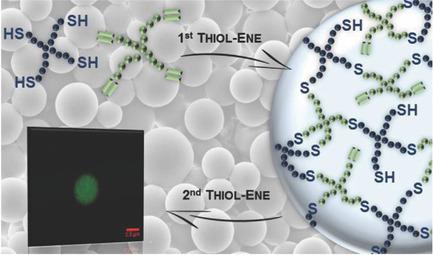当前位置:
X-MOL 学术
›
Macromol. Rapid Commun.
›
论文详情
Our official English website, www.x-mol.net, welcomes your
feedback! (Note: you will need to create a separate account there.)
TEMPO Driven Mild and Modular Route to Functionalized Microparticles
Macromolecular Rapid Communications ( IF 4.2 ) Pub Date : 2018-05-11 , DOI: 10.1002/marc.201800169 Sumbul Hafeez 1 , Leonie Barner 2, 3 , Leena Nebhani 1
Macromolecular Rapid Communications ( IF 4.2 ) Pub Date : 2018-05-11 , DOI: 10.1002/marc.201800169 Sumbul Hafeez 1 , Leonie Barner 2, 3 , Leena Nebhani 1
Affiliation

|
The synthesis of crosslinked polymeric microspheres (3.8–15.0 µm) via (2,2,6,6‐tetramethylpiperidin‐1‐yl)oxyl (TEMPO) initiated thiol‐ene dispersion polymerization under ambient conditions is reported for the first time. The initiating ability of TEMPO for the thiol‐ene reaction is validated by electron paramagnetic resonance (EPR) and 1H nuclear magnetic resonance (NMR) spectroscopy on model reactions between 1‐octadecanethiol and two electron deficient enes, n‐butylacrylate and divinyl sulfone. Critically, the TEMPO resonance observed in the EPR spectra decreases with time when TEMPO is mixed with thiol and an electron deficient ene. The 1H NMR spectra demonstrate formation of up to 90% of thioether under ambient conditions. Based on these model reactions, a variety of crosslinked polymeric microspheres are synthesized with excellent morphological stability using poly(vinyl pyrrolidone) as surfactant. The ability of the microspheres for a second TEMPO initiated thiol‐ene reaction is demonstrated by the ligation of fluorescein‐5‐maleimide (an ene) to the microspheres' surface containing excess of thiol functionality and by ligation of cysteine (containing a thiol group) to the microspheres' surface containing an excess of ene functionality. The synthesized polymeric microspheres are characterized using scanning electron microscopy, differential scanning calorimetry, Fourier‐transform infrared spectroscopy, zeta potential, and X‐ray photoelectron spectroscopy.
中文翻译:

TEMPO驱动的轻度和模块化路线通往功能化微粒
首次报道了在环境条件下通过(2,2,6,6-四甲基哌啶-1-基)氧基(TEMPO)引发的交联聚合物微球(3.8-15.0 µm)的合成。TEMPO引发硫醇反应的能力已通过电子顺磁共振(EPR)和1 H核磁共振谱(NMR)验证了1-十八烷硫醇与两种电子不足的烯(丙烯酸正丁酯和二乙烯基砜)之间的模型反应。至关重要的是,当TEMPO与硫醇和缺电子的烯混合时,在EPR光谱中观察到的TEMPO共振会随时间降低。在11 H NMR光谱证明在环境条件下最多形成90%的硫醚。基于这些模型反应,使用聚(乙烯基吡咯烷酮)作为表面活性剂,合成了具有优异形态稳定性的各种交联聚合物微球。微球进行第二次TEMPO引发的硫醇-烯反应的能力通过荧光素5-马来酰亚胺(烯)与含过量硫醇官能度的微球表面的连接以及半胱氨酸(含硫醇基)的连接来证明到含有过量烯官能团的微球表面。合成的聚合物微球的特征在于使用扫描电子显微镜,差示扫描量热法,傅立叶变换红外光谱,ζ电位和X射线光电子能谱。
更新日期:2018-05-11
中文翻译:

TEMPO驱动的轻度和模块化路线通往功能化微粒
首次报道了在环境条件下通过(2,2,6,6-四甲基哌啶-1-基)氧基(TEMPO)引发的交联聚合物微球(3.8-15.0 µm)的合成。TEMPO引发硫醇反应的能力已通过电子顺磁共振(EPR)和1 H核磁共振谱(NMR)验证了1-十八烷硫醇与两种电子不足的烯(丙烯酸正丁酯和二乙烯基砜)之间的模型反应。至关重要的是,当TEMPO与硫醇和缺电子的烯混合时,在EPR光谱中观察到的TEMPO共振会随时间降低。在11 H NMR光谱证明在环境条件下最多形成90%的硫醚。基于这些模型反应,使用聚(乙烯基吡咯烷酮)作为表面活性剂,合成了具有优异形态稳定性的各种交联聚合物微球。微球进行第二次TEMPO引发的硫醇-烯反应的能力通过荧光素5-马来酰亚胺(烯)与含过量硫醇官能度的微球表面的连接以及半胱氨酸(含硫醇基)的连接来证明到含有过量烯官能团的微球表面。合成的聚合物微球的特征在于使用扫描电子显微镜,差示扫描量热法,傅立叶变换红外光谱,ζ电位和X射线光电子能谱。











































 京公网安备 11010802027423号
京公网安备 11010802027423号